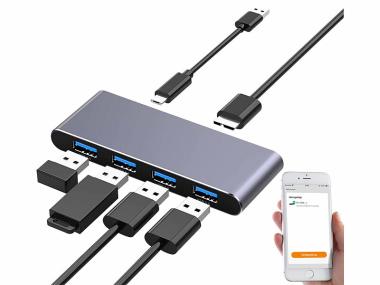In today’s digitally driven world, our reliance on efficient and reliable computer networks is undeniable. Behind the seamless flow of information, a critical piece of hardware often goes unnoticed: the network switch. This article delves into the world of network switches, exploring their functionalities, benefits, and how they contribute to a smoothly functioning network.
Demystifying the Network Switch: Function and Operation
Imagine a bustling office environment where information needs to flow freely between employees. In this scenario, a network switch serves as an intelligent traffic controller. Unlike its simpler cousin, the hub, which broadcasts data to all connected devices, a switch operates with greater precision.
Here’s a breakdown of how a network switch works:
Multi-Port Marvel: A network switch boasts multiple ports, each designed to connect a network device like a computer, printer, server, or another switch.
MAC Address Magic: Every network device has a unique identifier called a Media Access Control (MAC) address. This address acts like a digital fingerprint.
Learning on the Job: The switch maintains a learning table, a dynamic database that maps MAC addresses to specific ports. The switch reads the destination MAC address embedded in a data packet when it arrives at a port.
Smart Delivery: The switch identifies the port of the intended recipient device by consulting the learning table. The switch then forwards the data packet only to that specific port, ensuring efficient delivery.
Benefits of Network Switches: A Streamlined Network Experience
Network switches offer several advantages over traditional hubs, making them the preferred choice for modern networks:
Reduced Network Congestion: Regardless of the intended recipient, a hub-based network broadcasts data packets to all connected devices. This can lead to network congestion, causing slowdowns and delays. Network switches, on the other hand, direct data packets only to the intended recipient, significantly reducing unnecessary traffic and improving overall network performance.
Network switches can enhance network security by restricting data flow to specific ports based on MAC addresses. This restricts unauthorized devices from accessing sensitive information on the network.
Scalability for Growth: As businesses and organizations expand, their network requirements change. Network switches offer excellent scalability. By adding more switches and connecting them through additional ports, networks can easily expand to accommodate new devices without compromising performance.
Improved Bandwidth Allocation: Network hubs share bandwidth among all connected devices. This can lead to bottlenecks when multiple devices require high bandwidth for activities like video conferencing or large file transfers. Network switches provide dedicated connections between devices, ensuring optimal bandwidth allocation and smoother data transfer experiences.
Types of Network Switches: Choosing the Right Fit
The world of network switches isn’t a one-size-fits-all scenario. Different types of switches cater to varying network requirements.
Unmanaged Switches: These are basic switches, ideal for small networks or home setups. They offer plug-and-play functionality, with minimal configuration required.
Managed Switches: These advanced switches cater to larger and more complex networks. They provide a high level of control and configuration options. Network administrators can leverage managed switches to manage traffic flow, prioritize specific devices for bandwidth allocation, and implement advanced security measures.
Smart Switches: They provide basic configuration capabilities, such as VLAN creation (virtual local area networks) for segmenting the network, as well as ease of use comparable to unmanaged switches.
Beyond the Basics: Network Switches’ Advanced Features
While the core functionality revolves around intelligent data forwarding, modern network switches offer additional features that enhance network management and security:
Quality of Service (QoS): QoS enables network administrators to prioritize specific types of traffic, ensuring smoother performance for critical applications like video conferencing or VoIP calls.
Security Features: Managed switches can offer advanced security features like port security, which restricts unauthorized access to specific ports, and 802.1X authentication, which requires devices to have valid credentials before connecting to the network.
Power over Ethernet (PoE): PoE switches can deliver electricity to compatible devices like IP phones or security cameras over the same Ethernet cable used for data transmission, eliminating the need for separate power supplies.
The Network Switch: A Silent But Crucial Player
Network switches operate silently in the background, ensuring a smooth flow of data within the network. Understanding their function, benefits, and different types is essential for anyone involved in network design, management, or troubleshooting. By choosing the right switch for your network needs, you can build a reliable and efficient foundation for optimal network performance.
